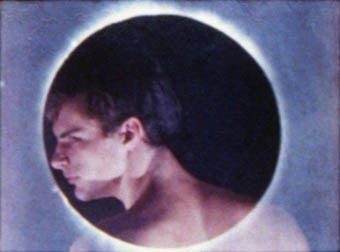Gregory Markopoulos
Seconds in Eternity
Cinema's long-lost "supreme erotic poet" has come back to the fold — briefly

How does it happen that a filmmaker once lauded as "the Americanavant-garde cinema's supreme erotic poet" vanishes entirely from the cultural landscape? Gregory Markopoulos was complicit in his own disappearance from the histories of modern art and cinema, where by any reasonable standard he belongs in the very forefront.
In 1967, after nearly two decades of brilliant, innovative filmmaking, Markopoulos and his lover, Robert Beavers, abandoned the U.S. for Greece. They not only left physically; they also prohibited the distribution of the films in America, refused interviews, and demanded the excision of a chapter on the director in P. Adams Sitney's seminal Visionary Film: The American Avant-Garde from later editions. It was only after his death (from lymphoma in 1992), and in fact only in the last year or so that Beavers, a vigilant guardian of Markopoulos's work, has allowed it to be shown in the U.S.
Seeing these films after 30 years of unavailability gives us a welcome chance to reevaluate this uniquely gifted artist. Born in 1928 in Toledo, Ohio, Markopoulos starting making movies at age 12. His subjects were classical and romantic: novels by Dickens, Bronte, and Hemingway. By the age of 18 he was well versed in cinema aesthetics and those whose work made the greatest case for cinema as art: Josef von Sternberg, Jean Cocteau, Buñuel. If we say he was influenced by these auteurs, it isn't to imply that he was derivative. His 1947-1948 trilogy Du sang, de la volupte, et la mort (Of Blood, of Pleasure, and of Death) already shows formal innovations that set his work apart and would continue to do so — specifically, the flash-cut, where the screen goes dark briefly between shots, creating a kind of trance state in the viewer. Later, he would expand this device to stunning effect with in-camera superimpositions, double-exposures, and the breathtaking "strobe-edit" where images flash on and off sometimes apart from, sometimes within other images. These strategies are part of Markopoulos's elliptical, imagistic approach to the narrative, where the viewer is seduced into participating in what's occurring onscreen in a way that's impossible in linear narrative.
Homosexual and lesbian themes appear in Du sang and other early films. Swain (1950), inspired by Nathaniel Hawthorne's Fanshawe, features a dreamlike narrative of a young man's ritualized rejection of heterosexuality, as a mysterious woman in white gossamer pursues him through a ruined landscape. The handsome Markopoulos appears in several of his own films, and stars in this one. By the early '60s, with works like Twice a Man (1963) and later, The Illiac Passion (1967), his celebration of the male body and an incorporation of homosexual imagery into a wider aesthetic fabric reaches its peak. Both films draw again on classical sources — the former the myth of Hippolytus and Phaedra, the latter Aeschylus's Prometheus Bound. The imagery inThe Illiac Passion is striking in its hypnotic repetitions, particularly in a sequence where a man repeatedly attempts to walk, but finds himself unable to move, perhaps trapped in the director's powerful mise-en-scene. The filmmaker isolates portions of the nude male body to fragment the viewer's perception, then flashes images of the whole man in naked splendor. Warhol regular Taylor Mead adds some amusing moments as a kind of demented bird-figure in a pink tattered dress, but most mesmerizing is the recurring motif of the romanticized male in a posture of longing. In one highly charged sequence, a beautiful man lies in a bathtub holding a scarab, which he slowly kisses.

Markopoulos's power as cinematic inventor extends to his soundtracks. In The Illiac Passion, he reads from Thoreau's translation of Prometheus Bound but he "edits" the words just as he does the images, repeating phrases as if they were chants, with the repetitions alternating with silences.
By the time of the short Ming Green (1966), Markopoulos had brought his formal innovations to an extraordinary level of clarity and simplicity. This brief film, a paean by the filmmaker to his New York apartment (the title refers to the color of the walls), dazzles the viewer with its use of the strobe-edit and the superimposition, bringing an empty, quiet space to gorgeous, glittering life.
A year after Ming Green, Markopoulos moved to Europe, where he continued to make films, some of which have yet to be developed. Like the classical sources that inspired his work, Greece held the promise of something he couldn't find in America, a kind of artistic purity without the demands of commerce or the more subtle pressures from a fickle avant-garde. He and Robert Beavers developed the idea of a pure exhibition space — an open-air field in the Greek countryside — in which to show his films. This concept, despite its practical difficulty, is in keeping with the poignant perfection of Markopoulos's artistry, and represents the same uncompromising ideal that drove his work.
November 1997
Gary Morris

